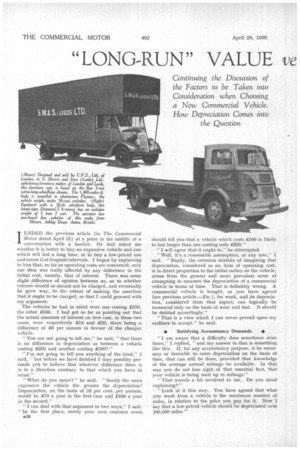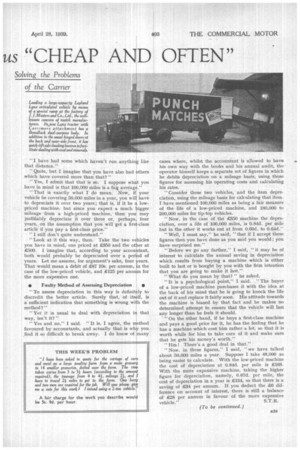"LONG-RUN" VALUE ye
Page 44

Page 45

If you've noticed an error in this article please click here to report it so we can fix it.
us "CHEAP AND OFTEN" IENDED the previous article (in The Commercial Motor dated April 21) at a point in the middle of a conversation with a haulier. He had asked me whether it is better to buy an expensive vehicle and one which will last a long time, or to buy a low-priced one and renew it at frequent intervals. I began by explaining to him that, so far as operating costs are concerned, only one item was really affected by any difference in the initial cost, namely, that of interest. There was some slight .difference of opinion between us, as to whether interest should or should not be charged, and eventually he gave way, to the extent of making the assertion that it ought to be charged, so that I could proceed with
my argument. • The vehicles he had in mind were one costing £350, the other £500. I had got so far as pointing out that the actual amounts of interest on first cost, in these two cases, were respectively £14 and £20, there being a difference of £6 per annum in favour of the cheaper vehicle.
" You are not going to tell me," he said, "that there is no difference in depreciation as between a vehicle costing £350 and another costing £500?"
"I'm not going to tell you anything of the kind," I said, "but before we have finished I may possibly persuade you to believe that whatever difference there is is in a direction contrary to that which you have in mind."
"What do you mean?" he said. "Surely the more expensive the vehicle the greater the depreciation? Depreciation, on the basis of 20 per cent: per annum, would be £70 a year in the first case and £100 a year in the second."
"I can deal with that argument in two ways," I said. "In the first place, surely your own common sense. a38 should tell you that a vehicle which costs £500 is likely to last longer than one costing only £850."
"I will agree that it ought to," he interrupted.
"Well, it's a reasonable assumption, at any rate," I said. "Really, the common mistake of imagining that depreciation, considered as an item of operating cost, is in direct proportion to the initial outlay on the vehicle, arises from the greater and more prevalent error of attempting to measure the depreciation of a commercial vehicle in terms of time. That is definitely wrong. A commercial vehicle is bought, as you have agreed [see previous article.—ED.1, for work, and its deprecia tion, considered from that aspect, can logically be measured only on the basis of wear and tear. It should be debited accordingly."
"That is a view which I can never prevail upon my auditors to accept," he said.
• Satisfying Accountancy Demands • "I am aware that a difficulty does sometimes arise there," I replied, "and my answer to that is something like this. If, for any accountancy purpose, it be necessary or desirable to enter depreciation on the basis of time, that can still be done, provided that knowledge of the average annual mileage be available. In that way you do not lose sight of that essential fact, that your vehicle is being used up in mileage."
"That sounds a bit involved to me. Do you mind explaining?"
" Look at it this way. You have agreed that what you want from a vehicle is the maximum number of miles, in relation to the price you pay for it. Now I say that a low-priced vehicle should be depreciated over 100,000 miles."
" I have had some which haven't run anything like that distance."
"Quite, but I imagine that you have also had others which have covered more than that?"
" Yes, I admit that that is so. I suppose what you have in mind is that 100,000 miles is a fair average." " That is exactly what I do mean. Now, if your vehicle be covering 50,000 miles in a year, you will have to depreciate it over two years; that is, if it be a lowpriced machine, but since you expect a much bigger mileage from a high-priced machine, then you may justifiably depreciate it over three or, perhaps, four years, on the assumption that you will get a first-class article if you pay a first-class price."
" I still don't quite understand."
"Look at it this way, then. Take the two vehicles you have in mind, one priced at £350 and the other at £500. I imagine that, according to your accountant, both would probably be depreciated over a period of years. Let me assume, for argument's sake, four years. That would mean a debit of £87 10s. per annum, in the case of the low-priced vehicle, and £125 per annum for the more expensive one.
• Faulty Method of Assessing Depredation • "To assess depreciation in this way is definitely to discredit the better article. Surely that, of itself, is a sufficient indication that something is wrong with the method?"
" Yet it is usual to deal with depreciation in that way, isn't it?"
"Yes and no," I said. "It is. I agree, the method favoured by accountants, and actually that is why you .find it so difficult to break away. I do know of many
cases where, whilst the accountant is allowed to have his own way with the books and his annual audit, the operator himself keeps a separate set of figures in which he debits depreciation on a mileage basis, using those figures for assessing his operating costs and calculating his rates.
" Consider these two vehicles, and the item depre. elation, using the mileage basis for calculating that item. I have mentioned 100,000 miles as being a fair measure of the life of a low-priced machine, and 180,000 to 200,000 miles for tip-top vehicles.
" Now, in the case of the £350 machine the depreciation, over a life of 100,000 miles, is 0.84d. per mile but in the other it works out at from 0.60d. to 0.64d."
"Well, I must say," he said, "that if I accept these figures then you have done as you said you would; you have surprised me."
"Before we go any farther," I said, "it may be of interest to calculate the annual saving in depreciation which results from buying a machine which is either built to last or is bought by you with the firm intention that you are going to make it last."
" What do you mean by that?" he asked.
"It is a psychological point," I said. "The buyer of a low-priced machine purchases it with the idea at the back of his mind that he is going to knock the life out of it and replace it fairly soon. His attitude towards the machine is biased by that fact and he makes no determined attempt to ensure that the vehicle will last any longer than he feels it should.
"On the other hand, if he buys a first-class machine and pays a good price for it, he has the feeling that he has a machine which cost him rather a lot, so that it is worth while for him to take care of it and make sure that he gets his money's worth."
" Hm I There's a good deal in that."
"Now, in these figures," I said, "we have talked about 50,000 miles a year. Suppose I take 48,000 as being easier to calculate. With the low-priced machine the cost of depreciation at 0.84d. per mile is £168. With the more expensive machine, taking the higher figure for depreciation, namely, 0.67d. per mile, the cost of depreciation in a year is £134, so that there is a saving of £34 per annum. If you deduct the £6 difference on account of interest, there is still a balance of £28 per annum in favour of the more expensive vehicle." S.T.R.
(To be continued.)












































































